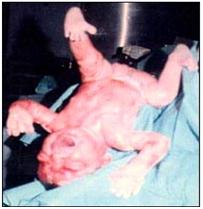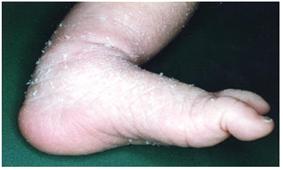태지, 몽고 반점, 황달, 피부비늘, Vernix, Mongolian spots, Jaundice, Scales

사진 2-132. 제왕절개분만으로 태어난 미숙 신생아의 피부가 태지로 덮여있다. 산과 의사가 기도 내 흡인물이나 분비물이 흘러나오도록 갓 태어난 아기를 거꾸로 잡고 있다
Copyright ⓒ 2011 John Sangwon Lee, MD., FAAP
- 갓 태어난 신생아의 피부는 부드럽고, 핑크색이거나 붉은 것이 보통이다. 물론 인종에 따라 갓 태어난 신생아의 피부색이 많이 다를 수 있다.
- 갓 태어난 신생아의 피부에 양수가 묻어 미끈거리고 하얀 크림과 비슷한 태지로 피부의 일부나 전체의 피부가 덮어 있을 수 있다.
- 특히 갓 태어난 미숙아들의 피부에 태지가 더 많이 묻어 있고 갓 태어난 미숙 신생아들이나 만삭 신생아들의 겨드랑이나 가랑이의 피부에 태지가 더 많이 묻어 있다.
- 태아 적 난 가는 배안 체모가 귓바퀴, 등, 어깨 등에 나 있고 이런 배안 체모는 생후 3∼4개월 이내 거의 없어지고 새로운 생후 체모로 대치된다.
- 출생 후 양수로 푹 적셔 있던 피부가 다 마르고 생후 1∼3일 동안 잘 먹지 않는 등 다른 이유로 출생 시 신생아의 체중이 출생 후 첫 며칠 동안에 점점 감소된다.
- 이런 이유로 피부가 정상적으로 더 쪼글쪼글해 질 수 있다.
- 일부의 신생아들의 피부의 각질층이 태어날 때부터 정상적으로 얇게 조금 벗겨질 수 있다(사진 2-135 참조).
- 다양하고 여러 가지 크기의 파란 피부 반점이 엉덩이, 허리, 등, 얼굴 또는 어깨 등의 피부에 날 수 있다.
- 이런 반점을 몽고반점이라고 한다([부모도 반의사가 되어야 한다- 소아가정간호 백과]-제 17권 소아 피부 질환 몽고반점 참조).
- 신생아 황달은 정상적으로 생기는 신생아 생리적 황달과 비정상적으로 생기는 병적 황달로 나눌 수 있다.
- 신생아 생리적 황달로 인해 생후 3∼7일에 피부와 눈 흰자위가 노랄 수 있다.
- 드물게는 병적 황달로 피부나 눈 흰자위가 노랗게 될 수 있다.
- 신생아 황달이 심할 때는 눈 흰자위와 피부의 색도 아주 노랗게 변한다.
- 신생아 질환-신생아 황달 참조).
- 갓 태어난 신생아가 아무 병이 없고 대체적으로 건강한 것 같으면 출생 2∼4시간에 끓여서 따뜻하게 식힌 목욕물로 목욕시킨 후 따뜻한 담요로 싸서 재운다.

사진 2-133. 신생아의 머리통의 후두개골의 두피의 맨 아래 부위에 난 혈관성 반점을 황새반점이라 한다. 이 반점은 자연히 없어진다.
Copyright ⓒ 2011 John Sangwon Lee, MD., FAAP

사진 2-134. 엉덩이 바로 위 중앙부위에 나 있는 몽고반점
Copyright ⓒ 2011 John Sangwon Lee, MD., FAAP

사진 2-135. 신생아의 피부에 인설(비듬)이 비정상적으로 많다. 그러나 이것도 1~2주 내 자연 치유된다. Copyright ⓒ 2011 John Sangwon Lee, MD., FAAP
Vernix, Mongolian spots, Jaundice, Scales 태지, 몽고 반점, 황달, 피부비늘

Photo 2-132. The skin of an immature newborn born only through a cesarean section is covered with a womb. Obstetrician holding newborn baby upside down so that aspiration or secretions from the airways are oozing Copyright ⓒ 2011 John Sangwon Lee, MD., FAAP
- Newborn babies skin is usually soft, pink, or red.
- Of course, depending on the race, the skin color of a newborn baby can be very different.
- Amniotic fluid is smeared on the skin of a newborn baby, which can cover part or all of the skin in a slimy, white cream-like form.
- In particular, the skin of newborn premature babies is covered by more vernix, and the skin of the armpits or crotch of newborns and full-term newborns is covered by more vernix.
- Fetal thin embryonic hairs are found on the auricles, back, and shoulders, and these embryonic hairs are almost disappeared within 3-4 months of life and are replaced with new postnatal hairs.
- After birth, the weight of the newborn baby gradually decreases during the first few days after birth for other reasons, such as dry skin that was soaked with amniotic fluid and not eating well for 1-3 days after birth.
- For this reason, the skin can become more fragile normally. In some newborns, the stratum corneum of the skin can be thinly peeled off normally from birth (see photo 2-135).
- Blue skin spots of different sizes can appear on the skin of the hips, waist, back, face, or shoulders.
- These spots are called Mongolian spots ([Parents should also be at least the half-doctors-Encyclopedia of Child and Family Nursing]-See Volume 17, Child Skin Diseases Mongolian spots).
- Neonatal jaundice can be divided into normal neonatal physiological jaundice and abnormal pathological jaundice.
- Due to physiological jaundice in newborns, the skin and whites of the eyes may become yellow on the 3rd to 7th day of life.
- Rarely, pathological jaundice can cause yellowing of the skin or whites of the eyes. When newborn jaundice is severe, the whites of the eyes and the color of the skin also turn very yellow. (Neonatal disease-see neonatal jaundice).
- If a newborn baby doesn’t have any disease and seems to be generally healthy, at birth for 2-4 hours, bathe it in warmly cooled bathwater, wrap it in a warm blanket, and put it to sleep.

Photo 2-133. Vascular spots on the bottom of the scalp of the occipital headof the newborn’s head are called stork spots. These spots disappear spontaneously. Copyright ⓒ 2011 John Sangwon Lee, MD., FAAP

Photo 2-134. Mongolian spots on the center of the hips. Copyright ⓒ 2011 John Sangwon Lee, MD., FAAP

Photo 2-135. There are abnormally many scales (dandruff) on the skin of newborns. However, this also heals naturally within 1-2 weeks. Copyright ⓒ 2011 John Sangwon Lee, MD., FAAP
출처 및 참조 문헌
- NelsonTextbook of Pediatrics 22ND Ed
- The Harriet Lane Handbook 22ND Ed
- Growth and development of the children
- Red Book 32nd Ed 2021-2024
- Neonatal Resuscitation, American Academy Pediatrics
- www.drleepediatrics.com 제1권 소아청소년 응급 의료
- www.drleepediatrics.com 제2권 소아청소년 예방
- www.drleepediatrics.com 제3권 소아청소년 성장 발육 육아
- www.drleepediatrics.com 제4권 모유,모유수유, 이유
- www.drleepediatrics.com 제5권 인공영양, 우유, 이유식, 비타민, 미네랄, 단백질, 탄수화물, 지방
- www.drleepediatrics.com 제6권 신생아 성장 발육 육아 질병
- www.drleepediatrics.com제7권 소아청소년 감염병
- www.drleepediatrics.com제8권 소아청소년 호흡기 질환
- www.drleepediatrics.com제9권 소아청소년 소화기 질환
- www.drleepediatrics.com제10권. 소아청소년 신장 비뇨 생식기 질환
- www.drleepediatrics.com제11권. 소아청소년 심장 혈관계 질환
- www.drleepediatrics.com제12권. 소아청소년 신경 정신 질환, 행동 수면 문제
- www.drleepediatrics.com제13권. 소아청소년 혈액, 림프, 종양 질환
- www.drleepediatrics.com제14권. 소아청소년 내분비, 유전, 염색체, 대사, 희귀병
- www.drleepediatrics.com제15권. 소아청소년 알레르기, 자가 면역질환
- www.drleepediatrics.com제16권. 소아청소년 정형외과 질환
- www.drleepediatrics.com제17권. 소아청소년 피부 질환
- www.drleepediatrics.com제18권. 소아청소년 이비인후(귀 코 인두 후두) 질환
- www.drleepediatrics.com제19권. 소아청소년 안과 (눈)질환
- www.drleepediatrics.com 제20권 소아청소년 이 (치아)질환
- www.drleepediatrics.com 제21권 소아청소년 가정 학교 간호
- www.drleepediatrics.com 제22권 아들 딸 이렇게 사랑해 키우세요
- www.drleepediatrics.com 제23권 사춘기 아이들의 성장 발육 질병
- www.drleepediatrics.com 제24권 소아청소년 성교육
- www.drleepediatrics.com 제25권 임신, 분만, 출산, 신생아 돌보기
- Red book 29th-31st edition 2021
- Nelson Text Book of Pediatrics 19th- 21st Edition
- The Johns Hopkins Hospital, The Harriet Lane Handbook, 22nd edition
- 응급환자관리 정담미디어
- Pediatric Nutritional Handbook American Academy of Pediatrics
- 소아가정간호백과–부모도 반의사가 되어야 한다, 이상원 저
- The pregnancy Bible. By Joan stone, MD. Keith Eddleman, MD
- Neonatology Jeffrey J. Pomerance, C. Joan Richardson
- Preparation for Birth. Beverly Savage and Dianna Smith
- 임신에서 신생아 돌보기까지. 이상원
- Breastfeeding. by Ruth Lawrence and Robert Lawrence
- Sources and references on Growth, Development, Cares, and Diseases of Newborn Infants
- Emergency Medical Service for Children, By Ross Lab. May 1989. p.10
- Emergency care, Harvey Grant and Robert Murray
- Emergency Care Transportation of Sick and Injured American Academy of Orthopaedic Surgeons
- Emergency Pediatrics A Guide to Ambulatory Care, Roger M. Barkin, Peter Rosen
- Quick Reference To Pediatric Emergencies, Delmer J. Pascoe, M.D., Moses Grossman, M.D. with 26 contributors
- Neonatal resuscitation Ameican academy of pediatrics
- Pediatric Nutritional Handbook American Academy of Pediatrics
- Pediatric Resuscitation Pediatric Clinics of North America, Stephen M. Schexnayder, M.D.
-
Pediatric Critical Care, Pediatric Clinics of North America, James P. Orlowski, M.D.
-
Preparation for Birth. Beverly Savage and Dianna Smith
-
Infectious disease of children, Saul Krugman, Samuel L Katz, Ann A.
- 제4권 모유, 모유수유, 이유 참조문헌 및 출처
- 제5권 인공영양, 우유, 이유, 비타민, 단백질, 지방 탄수 화물 참조문헌 및 출처
- 제6권 신생아 성장발육 양호 질병 참조문헌 및 출처
- 소아과학 대한교과서
-
Copyright ⓒ 2015 John Sangwon Lee, MD., FAAP
미국 소아과 전문의, 한국 소아청소년과 전문의 이상원 저 “부모도 반의사가 되어야 한다”-내용은 여러분들의 의사로부터 얻은 정보와 진료를 대신할 수 없습니다.
The information contained in this publication should not be used as a substitute for the medical care and advice of your doctor. There may be variations in treatment that your doctor may recommend based on individual facts and circumstances. “Parental education is the best medicine.”